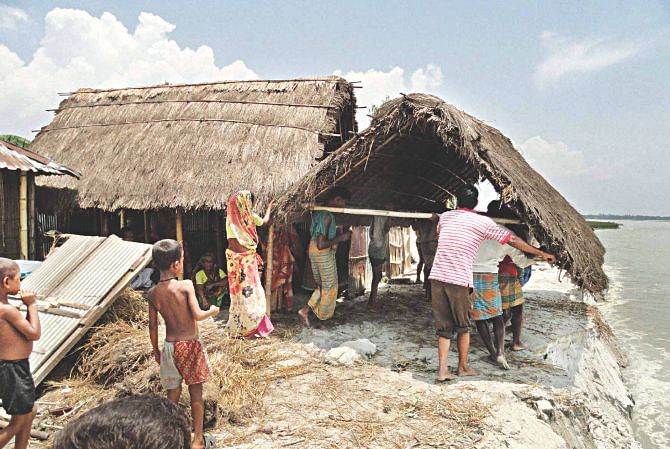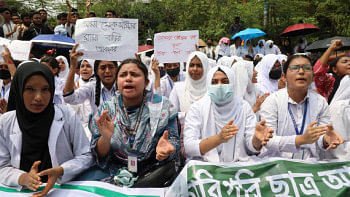Coping with river bank erosion: What should we focus on?
River bank erosion

RIVER bank erosion is a regular phenomenon in Bangladesh, which is located in the delta of three mighty rivers -- Ganges, Brahmaputra and Meghna. According to CEGIS, 88780 hac of land had been eroded along the Brahmaputra, 27,990 hac along the Padma and 38,510 hac along their distributaries between 1973 and 2007 (IRIN, 2010). About 15 to 20 million people are at risk from the effects of erosion in the country while about 1 million people living in 94 upazilas are directly affected by riverbank erosion every year. As per different sources, 500 kilometers of river bank face severe problems related to erosion. The northwest part of the country is particularly prone to river bank erosion, which has turned the region into an economically depressed area. About 1 million people are directly affected by river erosion every year and landlessness could be high as 70% (RMMRU, 2007).
Impact of river bank erosion
River bank erosion contributes immensely to the marginalisation process of a large number of people of the country by displacing households and adversely affecting their social and economical circumstances, triggering the flow of migration and increasing urban poverty as consequences. Although a number of policies and acts have been formulated with the aim of addressing of needs of marginalised people, the country is far from developing appropriate guidelines for addressing the causes and consequences of river bank erosion. Unfortunately, river bank erosion does not draw the attention of the government and non-government agencies as the other disasters do.
The affected people do not have access to institutional support and are not included in any rehabilitation programme, while the main issue is overlooked. When they are displaced from their birth places they become disconnected from their sources of income, lands, food production and other livelihood options, which forces them to engage in new livelihood activities. Education of their children is disrupted, and they are deprived of safe water, sanitation and other basic needs.
Coping mechanism
As part of their coping mechanism, the affected people depend on their local knowledge and strategies. When rainy season comes and if erosion begins, they start shifting their belongings to safer places. The households experiencing river bank erosion first send away their women and children to safely. Those who have access to boats and manpower can save their belongings while others could lose everything.
A few of them who have the capacity to buy new land shift there while most of them continue to live in temporary shelters for a long time. Most of the households are forced to sell their personal belongings to survive after displacement. The place of resettlement completely depends on their networks, availability of the options and social kinship. Other factors also impact the choice of destination. As part of long term survival strategy, support from government and NGOs, and credit and loans from relatives and neighbours help them a lot to begin a new livelihood. It is not easy for them to gain access to banks or other financial institutions for credit or loans.
How to address river bank erosion
There is a major gap in coordination among the various government agencies and also between the government and non-government initiatives with regard to water logging. The government initiative is mainly focused on some subsidy programmes including relief distribution, Vulnerable Group Feeding (VGF), Vulnerable Group Development (VGD), etc., however, these programmes are often inadequate, disorganised, politicised, ad-hoc and ineffective; thus there is much scope for improvement of government initiatives. Close coordination is prerequisite to reduce the problem among different local government institutions. On the other hand, few NGOs have specific programmes targeting those affected by river bank erosion although they make enormous efforts for addressing the other disasters, both natural and man-made.
The government should include river bank erosion disaster in its five year programmes and a clear vision should be set for addressing it. A data base is required to assess the magnitude of river bank erosion and the number of people affected by it. A national habitat policy should be formulated that would ensure the need for shelter of thousands of people displaced every year. In all these phases, local government agencies should play the lead role and they should have the statistics of possible affected people who live in the risky side of the river. Along with these, local government agencies should be decentralised and have the capacity along with accountability mechanism with the aim of reducing vulnerability, and responding quickly and effectively.
Besides these broader aspects, there is a need to implement some activities in the river bank erosion prone areas, including setting up early warning systems in all the critical zones and monitoring during critical periods using the local knowledge; establishing embankments or spurs in the erosion affected areas; generating alternative employment opportunity related to fishing and industry; and taking initiatives to distribute 'khas' land to most vulnerable people. This 'khas' land distribution programme may reduce the flow of migration to the urban areas.
During rehabilitation of the affected community in the erosion prone areas, there should be a resettlement plan for income generating activities and development of health care facilities, services and education. NGOs can provide flexible credit schemes to the affected people so that they can immediately restart their income generating activities. NGOs can campaign for rights- based advocacy campaign so that affected people may be encouraged to demand access to education, health care, water, sanitation and work opportunities as part of their rights.
Considering the magnitude and intensity, it is high time to develop national level strategies for better response to floods and riverbank erosion disasters. We may not be able to fight against the forces of nature, but we can develop strategies to fight the consequences.
The writers are Nation Urban Coordinator at World Vision Bangladesh and, GIS Analyst at Helen Keller International, respectively.
Email: [email protected]

 For all latest news, follow The Daily Star's Google News channel.
For all latest news, follow The Daily Star's Google News channel. 



Comments